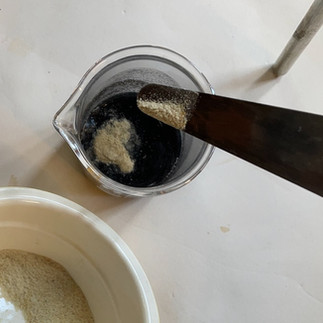Medieval ink on a medieval budget
- Sara Charles
- Sep 29, 2023
- 4 min read
Updated: Sep 30, 2023
As autumn is the season for collecting oak galls, now seems a good time to consider how to make ink without access to the standard ingredients of oak galls, ferrous sulphate and gum arabic. Perhaps you are in an early medieval monastery in a remote part of Britain or Ireland and are desperate to write the word of God on some parchment. Or perhaps you are an itinerant cleric, who has just woken up to find the cat has knocked your jar of ink off the shelf and your yet-to-be-copied documents are due in the next few days.

So – you need some ink quickly, using what sources you have on hand. Of course, carbon ink made from soot is always a cheap and readily available alternative, but you would really prefer the superior oak ink. If you were a resourceful medieval scribe, what alternatives could you use?
First of all, you need a source of tannin. The galls that are found on oak trees are the easiest way to get hold of some - but alas, your stock is depleted. Perhaps the finest Lombardi marble galls sold at the market are out of your price range, or not easily shipped in to your remote island. Perhaps even the locally sourced apple galls were in short supply this year. Fortunately, as long as you have access to an oak tree, you can simply use bark chippings. Just scrape some off an oak log from the stack of chopped firewood, or get some chips from the local tanner.
Now you have a handful of oak bark chips, you need to soak them in rainwater - preferably over a bit of heat. An hour or so should do the trick, to make sure that the tannic acid from the bark leaches into the water. Strain the mixture through some linen cloth.
The liquid will be a rich brown colour, but you want the deep black that lasts permanently - so you need to add some iron. Ferrous sulphate was manufactured from natural deposits of iron pyrite in the medieval period, but again our stocks have run dry and we need to find easily available materials. Chucking a few rusty iron nails in a jar with vinegar poured over them will provide the same effect as ferrous sulphate. Being a medieval, you are not so bothered about the potential danger of this. You might even reclaim the iron nails from the vinegar once their purpose has been served.
Leave the nails to soak for a few days. It will start to look very toxic, so handle with extreme care. The iron and vinegar should give the solution enough oomph to create a chemical reaction when combined with tannic acid, immediately turning the mixture black. Only two drops are needed to visibly change the colour, as you can see in the video below. You can add more, but the downside is the iron solution may be too strong and start to corrode the paper or parchment after a few years. But this is a quick fix and we are deliberately not getting hung up on the perfect recipe or ingredients.
The final ingredient is the gum arabic, which acts as a binder and helps the ink flow from the quill to the parchment and adhere to it. But gum arabic comes from faraway lands, harvested from the sticky sap of the acacia tree. Surely there must be a local, native alternative? Luckily, there is - the sap from a cherry tree. This may not be as highly prized as gum arabic, but it will do the job. Hopefully you will have a few chunks of cherry tree gum laying around, which you can grind up into a fine powder. Once that's done, you can add the powder to the mixture, creating a silky texture to the dark liquid.
The ink is technically looking like an ink should, so now it's time to test your product. All right, so it hasn't been made with the finest of ingredients, and it is definitely not as deep black or easy to write with as iron gall ink - but it still works. If you were in a hurry and needed an oak ink, you have here a choice of three different substitutes for the main ingredients, bark chips for galls, rusty nails soaked in vinegar for ferrous sulphate and cherry tree gum for gum arabic - hopefully you would only need one or two of these substitutes.
There is still a lot of mystery around how exactly British and Irish medieval scribes made their ink - did they use marble galls or local apple galls? Would they have used the green crystals of manufactured ferrous sulphate, or made do with some iron nails? And would gum arabic have been sought after when local plant gums served the same purpose? Surviving medieval ink recipes seldom elaborate on alternatives and besides, we do not know how strictly they were adhered to in the first place. Like many medieval processes, the connection to the natural world was assumed to be too fundamental to have to write down - most artisans and scribes would have absorbed a basic knowledge of how to use their local landscape to suit their needs. And fortunately for iron gall ink, there were cheaper alternatives that could be sourced closer to home, so hopefully there was a recipe to suit all medieval budgets and situations.


























